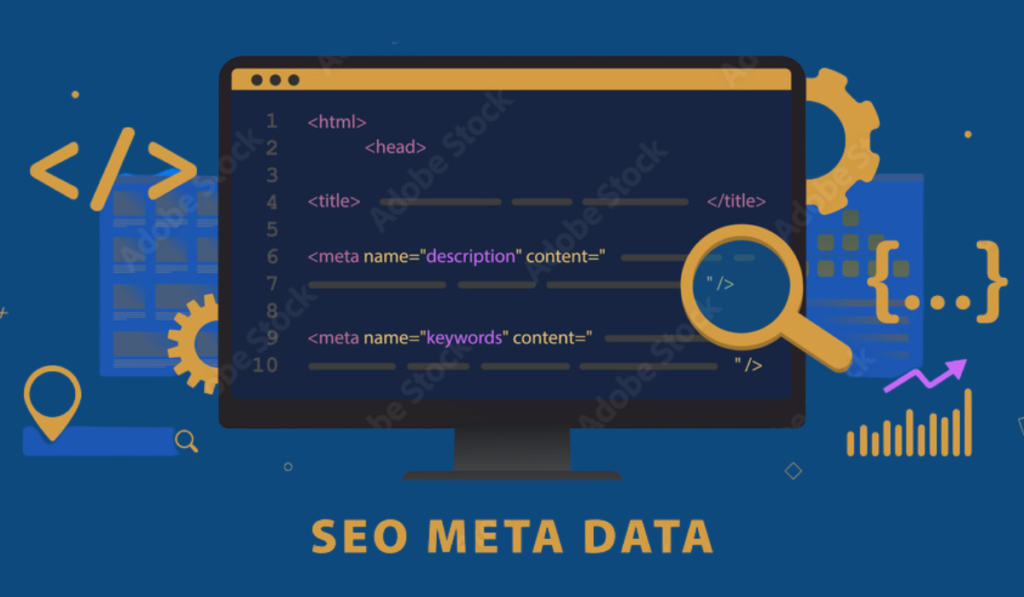Given your inexperience with search engine optimization (SEO), you may have heard of the phrase “meta tags.” These are essential components of on-page SEO, even though their significance is occasionally overlooked. You must understand the concept of meta title and description, as well as their function and SEO optimization techniques if you want to make improvements to your website.
What do meta descriptions and titles mean?
Often called “meta tags,” the HTML code that pops up in search results offers meta title and description. They provide a synopsis of the page’s contents, informing everyone search engine crawlers and site visitors of what’s there.
The meta title appears at the head of the browser and in search engine results. It is sometimes referred to as the title tag or page title.
Why are meta titles and descriptions important?
Since Google decided that meta tags are not ranking criteria, their importance is primarily in improving the click-through rate (CTR) of web pages rather than in influencing ranks. However, search engines still utilize information from these tags.
Because the terms in them get bolded when a user searches, meta titles and descriptions are crucial. Because of this, consumers can quickly determine if a website is relevant to their search queries, which sets well-optimized websites apart from the competition.
Using meta titles and descriptions also persuades search engine visitors to follow through to your website. Writing them correctly and using them to drive visitors to your site is one of the most effective strategies to boost traffic.
Users can judge the relevancy of the content by reading the meta titles and descriptions that show when pages get shared on social media. Strong meta tags can drive more clicks from social media shares, demonstrating their importance beyond search engine results.
Do meta descriptions affect SEO?
Although meta descriptions have no direct impact on SEO rankings, they’ve got a big impact on search engine results page (SERP) click-through rates (CTR).
The impact of meta descriptions on SEO is as follows:
In search engine results, a well-written meta description may greatly increase click-through rates (CTR). Increased CTR indicates to search engines that your page is valuable and relevant to users, indirectly influencing rankings.
Moreover, interesting information found via these clicks may enhance user metrics like bounce rates and time spent on the page which search engines utilize as markers of high-quality content.
Without keyword stuffing, using pertinent keywords in your meta description informs search engines of your page’s alignment with particular search queries. This approach enhances the likelihood of your content matching user intent.
Moreover, on social media platforms, meta descriptions serve as default descriptions when pages are shared. A compelling meta description enhances click-through rates from social shares, potentially driving more traffic and acquiring backlinks.
Do meta titles affect SEO?
The meta title holds significant importance in SEO, exerting a similar level of influence as the meta description on search engine outcomes.
Here are a few reasons why the meta title holds importance for SEO:
Search Engine Ranking
One important factor that search engines utilize to assess a page’s relevancy to a user’s query is its meta title. The likelihood of ranking better in search results improves when the meta title contains relevant keywords.
Users’ Click-Through Rate (CTR)
Usually, the first thing consumers see in search results is the meta title. A compelling meta title encourages more clicks from users, which raises click-through rates (CTR). A higher click-through rate (CTR) can yield better results and is a good indication to search engines.
User Experience
A clear, useful meta title helps people quickly understand the page’s content, which improves their browsing experience and influences their decision to click on the link. Indirectly supporting SEO efforts are positive user behaviors like lower bounce rates and longer time spent on the page.
How to Optimize Your Meta Title
Search engines typically display a limited number of pixels from each meta tag, such as around 55 to 70 characters for meta titles, equating to about 600 pixels. To ensure visibility on both mobile and desktop devices, it’s advisable to keep meta titles concise, focusing on naturally incorporating relevant keywords while indicating the page’s content.
Each page on your site must feature a unique meta title. Search engines interpret identical meta titles as duplicate content, potentially impacting your search rankings. Moreover, if search engines rewrite your meta title, your optimization efforts may not yield the desired results. Crafting distinct meta titles for each page maximizes your chances of achieving higher rankings.
When faced with similar pages sharing duplicate meta descriptions, simply rephrasing them can resolve duplicate content issues effectively.
How long should a meta description be?
To optimize your meta description’s exposure on search engine results pages, keep it to 155 characters or less.
How to Make a Meta Description Better
To avoid appearing spammy to search engines, a well-written meta description incorporates relevant keywords naturally while providing a brief overview of the content of your webpage. Readers should find it intriguing enough to go over to your page.
Effective meta descriptions strike a balance by informing users about the webpage’s content without revealing everything, supplemented with a clear call to action (CTA) such as “buy now” for product pages, “read our blog” for blogs, or “find out more” for informational pages. This prompts users on what action to take after reading the description, increasing the likelihood of them clicking the link.
Each webpage should feature a unique meta description that accurately reflects its content and purpose. This ensures relevance and supports search engine optimization efforts, whether it’s detailing how a product enhances user life on a product page or representing the entirety of a business on a homepage.
Do search engines always use the meta tags provided?
Search engines can override the meta title and description you set if they deem them irrelevant to the user’s query or if the meta description fails to accurately represent the page’s content. In such cases, search engines will derive information directly from the page to determine more suitable meta titles and descriptions.
This means that if a section of your page addresses a user’s query better than your meta description, Google may opt to display that content in the search results instead. To ensure your meta title and description align with specific search queries, it’s crucial to optimize them accordingly and ensure relevance to the page content.
Google may also generate its own meta description or title under various circumstances, such as when none is provided, when duplicates are detected across the site, or when existing tags are outdated.
Despite the potential for Google to rewrite meta tags, it remains important to craft them thoughtfully. Google relies on provided meta tags in the majority of cases (87%), underscoring their continued relevance and importance in SEO practices.
Google’s Guidelines on Title Tag Width Changes
If you’re not yet aware, Google has recently conducted tests involving a notable adjustment to the width of the left-hand column containers, increasing it from 512 pixels to 600 pixels, marking a 17% expansion. Concurrently, Google has also extended the maximum length allowed for result titles.
So how many characters can we use in our title tags now?
The actual answer varies due to the nature of Google’s use of the Arial font for titles, which is proportional. This means that different characters occupy varying amounts of space. To play it safe, it’s advisable to aim for titles under 60 characters. However, Google now supports titles up to approximately 73 characters in length.
What were the limits before the change?
In recent years, the standard advice has been to aim for title tags under 55 characters, with an upper limit of around 60 characters.
Are these changes permanent?
Google has not yet confirmed whether these adjustments are temporary tests or permanent changes. It’s wise to refrain from making significant alterations to your title tags until the situation is clarified.
We’ll continue to monitor updates closely and keep you informed of any developments regarding the length of meta titles and descriptions. To avoid appearing spammy to search engines, a well-written meta description incorporates relevant keywords naturally while providing a brief overview of the content of your webpage. Readers should find it intriguing enough to go over to your page.

